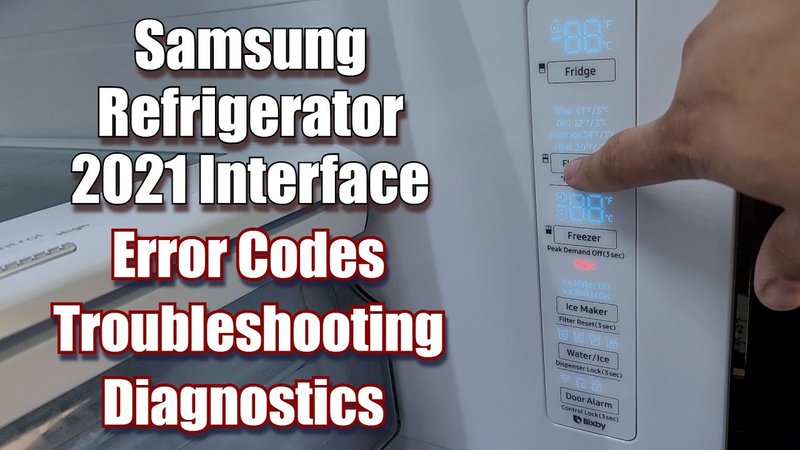
Error Code E3 specifically isn’t a signal to panic, but certainly a call to action. It usually indicates a problem with the defrosting system, which can lead to issues like reduced cooling efficiency or frost build-up. Imagine it’s like having a clogged nose; your fridge just can’t breathe freely, so it needs a bit of help. The trick lies in knowing when a little DIY can do the job and when it’s time to bring in the professionals.
Understanding Error Code E3 in Samsung Refrigerators
First off, let’s demystify this error code. When your Samsung refrigerator displays an E3 code, it’s gently nudging you to check its defrost sensor or heater. Think of it like a smoke alarm, alerting you to potential trouble. Refrigerators have a defrost cycle to melt away any frost build-up in the freezer, ensuring optimal performance. If this system encounters issues, like a faulty defrost sensor, it can’t properly regulate the temperature, leading to the infamous E3 code.
You might be curious, why does frost even build up? Well, it’s akin to a warm breeze on a cold day, where condensation leads to ice formation. Similarly, when warm air leaks into the freezer, frost forms. If the defrost system isn’t working as it should, it becomes a vicious cycle of accumulating ice. This not only affects cooling but can also stress other components.
Now, before you jump to conclusions, check your refrigerator’s manual. Sometimes, a simple reset after a power outage or minor adjustments in settings can clear this error. However, if the code persists and your refrigerator doesn’t return to its normal efficiency, it’s time to delve deeper or call in professional help.
Common Causes of Error Code E3
It’s essential to grasp what might trigger Error Code E3. Think of it as diagnosing a cold; understanding the symptoms can guide you to the right remedy. A faulty defrost sensor is often at the heart of the issue. This sensor monitors the temperature in your freezer, and if it malfunctions, the defrost cycle can’t kick in properly. Imagine trying to bake without a timer; you’re bound to miss the mark.
Another possible culprit is a defective defrost heater. This component does the heavy lifting, melting any accumulated frost. When it falters, frost lingers, potentially leading to that dreaded error code. It’s like when your heater stops working in winter; things get chilly fast.
Finally, consider the defrost timer. This little device orchestrates the entire cycle, ensuring everything runs smoothly. If it’s on the fritz, the whole defrost operation could falter. Think of it like a misfiring conductor in an orchestra; disorder ensues. Identifying these causes can empower you with the knowledge to make informed decisions about repair or replacement.
When to Call a Technician
Now, let’s talk about when to step aside and let the experts handle it. You might feel like tackling this head-on, but some battles are better left to seasoned pros. If your attempts at resetting the refrigerator or checking the manual don’t yield results, it’s a sign to pick up that phone.
Another clue is if you notice persistent frost build-up or your refrigerator failing to maintain its usual temperature. It’s like trying to ignore a headache that won’t quit; eventually, you need a doctor’s visit. A professional technician can diagnose the issue accurately and make necessary repairs, ensuring you don’t end up in a worse situation.
Moreover, if any electrical components like wires seem damaged or burnt, it’s crucial to involve a professional. Electrical repairs can be dangerous without the proper knowledge and tools, much like attempting to fix faulty wiring on your own. In these cases, safety is paramount.
Preventative Tips to Avoid Error Code E3
While we’ve covered how to handle Error Code E3, preventing it is ideal. Regular maintenance is key, akin to keeping your car serviced to avoid breakdowns. Start by ensuring the refrigerator’s seals are intact, preventing warm air from sneaking in. Imagine it like keeping your windows closed during a storm; it keeps everything inside dry and safe.
Keep an eye on your freezer’s temperature settings. If it’s set too low, frost formation becomes more likely, much like leaving an ice tray directly under the freezer fan. Adjust the settings according to the manufacturer’s guidelines to strike the perfect balance.
Lastly, consider scheduling routine check-ups with a technician, especially if your refrigerator is aging. Think of it as a health check-up for your fridge. This proactive step can catch potential issues early, saving you time, money, and stress in the long run. By keeping these pointers in mind, you’ll ensure long-lasting performance from your Samsung refrigerator, free from unexpected surprises.
